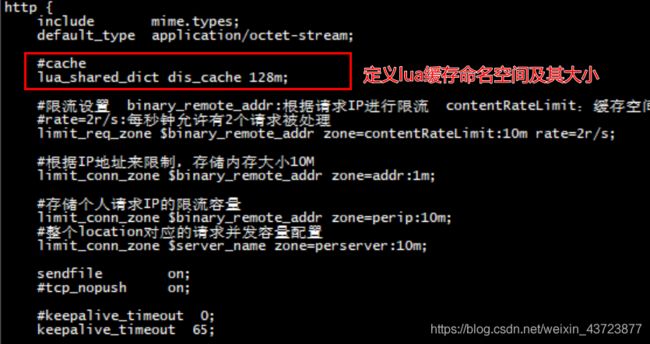用OpenResty实现广告缓存的载入与读取
文章目录
- 一、需求分析
- 二、实现思路
-
- 1.Lua是什么
- 2.OpenResty介绍
-
- 2.1 安装OpenResty
- 2.2 安装nginx
- 2.3 测试访问
- 三、广告缓存的载入与读取
-
- 3.1 流程
- 3.2 Lua+Nginx配置
- 3.3 nginx限流
-
- 3.3.1 nginx限流的两种方式
一、需求分析
首页需要展示各种各样的广告数据,以JD为例:

如图,广告大图这种变更频率低的数据,如何提升访问速度呢?
1 数据做成静态页(商品详情页)
2 做缓存(Redis)
二、实现思路
通常情况下,首页的流量一般非常高,不适合直接通过数据库查询数据给用户
1.Lua是什么
https://blog.csdn.net/weixin_43723877/article/details/108608874
2.OpenResty介绍
OpenResty(又称:ngx_openresty) 是一个基于 nginx的可伸缩的 Web 平台,由中国人章亦春发起,提供了很多高质量的第三方模块。
OpenResty 是一个强大的 Web 应用服务器,Web 开发人员可以使用 Lua 脚本语言调动 Nginx 支持的各种 C 以及 Lua 模块,更主要的是在性能方面,OpenResty可以 快速构造出足以胜任 10K 以上并发连接响应的超高性能 Web 应用系统。
360,UPYUN,阿里云,新浪,腾讯网,去哪儿网,酷狗音乐等都是 OpenResty 的深度用户。
OpenResty 简单理解成 就相当于封装了nginx,并且集成了LUA脚本,开发人员只需要简单的其提供了模块就可以实现相关的逻辑,而不再像之前,还需要在nginx中自己编写lua的脚本,再进行调用了。
2.1 安装OpenResty
linux安装openresty:
1.添加仓库执行命令
yum install yum-utils
yum-config-manager --add-repo https://openresty.org/package/centos/openresty.repo
2.执行安装
yum install openresty
3.安装成功后 会在默认的目录如下:
/usr/local/openresty
2.2 安装nginx
默认已经安装好了nginx,在目录:/usr/local/openresty/nginx 下。
修改/usr/local/openresty/nginx/conf/nginx.conf,将配置文件使用的根设置为root,目的就是将来要使用lua脚本的时候 ,直接可以加载在root下的lua脚本。
cd /usr/local/openresty/nginx/conf
vi nginx.conf
2.3 测试访问
重启下centos虚拟机,然后访问测试Nginx
三、广告缓存的载入与读取
3.1 流程
3.2 Lua+Nginx配置
(1)查询数据放入到Redis中
实现思路:定义请求:用于查询数据库的数据更新到redis中。
a.连接mysql,按照广告分类id读取广告列表,转换为json字符串。
b.连接redis,将广告列表json字符串存入redis。
定义请求:
请求:
/update_content
参数:
id --指定广告分类的id
返回值:
json
请求地址:
创建/root/lua/68目录,在该目录下创建update_content.lua: 目的就是连接mysql 查询数据 并存储到redis中。
ngx.header.content_type="application/json;charset=utf8"
local cjson = require("cjson")
local mysql = require("resty.mysql")
local uri_args = ngx.req.get_uri_args()
local id = uri_args["id"]
local db = mysql:new()
db:set_timeout(1000)
local props = {
host = "192.168.5.128",
port = 3306,
database = "changgou_content",
user = "root",
password = "123456"
}
local res = db:connect(props)
local select_sql = "select url,pic from tb_content where status ='1' and category_id="..id.." order by sort_order"
res = db:query(select_sql)
db:close()
local redis = require("resty.redis")
local red = redis:new()
red:set_timeout(2000)
local ip ="192.168.5.128"
local port = 6379
red:connect(ip,port)
red:set("content_"..id,cjson.encode(res))
red:close()
ngx.say("{flag:true}")
修改/usr/local/openresty/nginx/conf/nginx.conf文件: 添加头信息,和 location信息

location /read_content {
#使用限流配置
limit_req zone=contentRateLimit burst=4 nodelay;
content_by_lua_file /root/lua/68/read_content.lua;
}
定义lua缓存命名空间,修改nginx.conf,添加如下代码即可:
lua_shared_dict dis_cache 128m;
实现思路:定义请求,用户根据广告分类的ID 获取广告的列表。通过lua脚本直接从redis中获取数据即可。
定义请求:
请求:/read_content
参数:id
返回值:json
在/root/lua/68目录下创建read_content.lua:
--设置响应头类型
ngx.header.content_type="application/json;charset=utf8"
--获取请求中的参数ID
local uri_args = ngx.req.get_uri_args();
local id = uri_args["id"];
--引入redis库
local redis = require("resty.redis");
--创建redis对象
local red = redis:new()
--设置超时时间
red:set_timeout(2000)
--连接
local ok, err = red:connect("192.168.5.128", 6379)
--获取key的值
local rescontent=red:get("content_"..id)
--输出到返回响应中
ngx.say(rescontent)
--关闭连接
red:close()
在/usr/local/openresty/nginx/conf/nginx.conf中配置如下:
location /read_content {
content_by_lua_file /root/lua/read_content.lua;
}
(3)加入openresty本地缓存
如上的方式没有问题,但是如果请求都到redis,redis压力也很大,所以我们一般采用多级缓存的方式来减少下游系统的服务压力。参考基本思路图的实现。

修改read_content.lua文件,代码如下:

ngx.header.content_type="application/json;charset=utf8"
local uri_args = ngx.req.get_uri_args();
local id = uri_args["id"];
--获取本地缓存
local cache_ngx = ngx.shared.dis_cache;
ngx.say(contentCache)
--根据ID 获取本地缓存数据
local contentCache = cache_ngx:get('content_cache_'..id);
if contentCache == "" or contentCache == nil then
local redis = require("resty.redis");
local red = redis:new()
red:set_timeout(2000)
red:connect("192.168.5.128", 6379)
local rescontent=red:get("content_"..id);
if ngx.null == rescontent then
local cjson = require("cjson");
local mysql = require("resty.mysql");
local db = mysql:new();
db:set_timeout(2000)
local props = {
host = "192.168.5.128",
port = 3306,
database = "changgou_content",
user = "root",
password = "123456"
}
local res = db:connect(props);
local select_sql = "select url,pic from tb_content where status ='1' and category_id="..id.." order by sort_order";
res = db:query(select_sql);
local responsejson = cjson.encode(res);
red:set("content_"..id,responsejson);
ngx.say(responsejson);
db:close()
else
cache_ngx:set('content_cache_'..id, rescontent, 2*60);
ngx.say(rescontent)
end
red:close()
else
ngx.say(contentCache)
end
测试地址:http://192.168.5.128/read_content?id=1
3.3 nginx限流
一般情况下,首页的并发量是比较大的,即使 有了多级缓存,当用户不停的刷新页面的时候,也是没有必要的,另外如果有恶意的请求 大量达到,也会对系统造成影响。
而限流就是保护措施之一。
3.3.1 nginx限流的两种方式
- 控制速率
- 控制并发连接数
(1)控制速率
漏桶算法实现控制速率限流
漏桶(Leaky Bucket)算法思路很简单,水(请求)先进入到漏桶里,漏桶以一定的速度出水(接口有响应速率),当水流入速度过大会直接溢出(访问频率超过接口响应速率),然后就拒绝请求,可以看出漏桶算法能强行限制数据的传输速率.示意图如下:

修改/usr/local/openresty/nginx/conf/nginx.conf:
user root root;
worker_processes 1;
events {
worker_connections 1024;
}
http {
include mime.types;
default_type application/octet-stream;
user root root;
worker_processes 1;
events {
worker_connections 1024;
}
http {
include mime.types;
default_type application/octet-stream;
#cache
lua_shared_dict dis_cache 128m;
#限流设置 binary_remote_addr:根据请求IP进行限流 contentRateLimit:缓存空间名称 10m:缓存空间
#rate=2r/s:每秒钟允许有2个请求被处理
limit_req_zone $binary_remote_addr zone=contentRateLimit:10m rate=2r/s;
#根据IP地址来限制,存储内存大小10M
limit_conn_zone $binary_remote_addr zone=addr:1m;
#存储个人请求IP的限流容量
limit_conn_zone $binary_remote_addr zone=perip:10m;
#整个location对应的请求并发容量配置
limit_conn_zone $server_name zone=perserver:10m;
sendfile on;
#tcp_nopush on;
#keepalive_timeout 0;
keepalive_timeout 65;
#gzip on;
server {
listen 80;
server_name localhost;
location /update_content {
content_by_lua_file /root/lua/68/update_content.lua;
}
location /read_content {
#使用限流配置
limit_req zone=contentRateLimit burst=4 nodelay;
content_by_lua_file /root/lua/68/read_content.lua;
}
#所有品牌请求
location /brand {
#limit_conn addr 2;
#个人IP限流配置
limit_conn perip 3;
#当前location的总并发量配置
limit_conn perserver 5;
proxy_pass http://192.168.43.5:18081;
}
}
}
配置说明:
binary_remote_addr 是一种key,表示基于 remote_addr(客户端IP) 来做限流,binary_ 的目的是压缩内存占用量。
zone:定义共享内存区来存储访问信息, contentRateLimit:10m 表示一个大小为10M,名字为contentRateLimit的内存区域。1M能存储16000 IP地址的访问信息,10M可以存储16W IP地址访问信息。
rate 用于设置最大访问速率,rate=10r/s 表示每秒最多处理10个请求。Nginx 实际上以毫秒为粒度来跟踪请求信息,因此 10r/s 实际上是限制:每100毫秒处理一个请求。这意味着,自上一个请求处理完后,若后续100毫秒内又有请求到达,将拒绝处理该请求.我们这里设置成2 方便测试。
测试:
重新加载配置文件
cd /usr/local/openresty/nginx/sbin
./nginx -s reload
访问页面:http://192.168.5.128/read_content?id=1 ,连续刷新会直接报错。
(3)处理突发流量
上面例子限制 2r/s,如果有时正常流量突然增大,超出的请求将被拒绝,无法处理突发流量,可以结合 burst 参数使用来解决该问题。
server {
listen 80;
server_name localhost;
location /update_content {
content_by_lua_file /root/lua/update_content.lua;
}
location /read_content {
limit_req zone=contentRateLimit burst=4;
content_by_lua_file /root/lua/read_content.lua;
}
}
burst 译为突发、爆发,表示在超过设定的处理速率后能额外处理的请求数,当 rate=10r/s 时,将1s拆成10份,即每100ms可处理1个请求。
此处,**burst=4 **,若同时有4个请求到达,Nginx 会处理第一个请求,剩余3个请求将放入队列,然后每隔500ms从队列中获取一个请求进行处理。若请求数大于4,将拒绝处理多余的请求,直接返回503.
不过,单独使用 burst 参数并不实用。假设 burst=50 ,rate依然为10r/s,排队中的50个请求虽然每100ms会处理一个,但第50个请求却需要等待 50 * 100ms即 5s,这么长的处理时间自然难以接受。
因此,burst 往往结合 nodelay 一起使用。
例如:如下配置:
server {
listen 80;
server_name localhost;
location /update_content {
content_by_lua_file /root/lua/update_content.lua;
}
location /read_content {
limit_req zone=contentRateLimit burst=4 nodelay;
content_by_lua_file /root/lua/read_content.lua;
}
}
如上表示:
平均每秒允许不超过2个请求,突发不超过4个请求,并且处理突发4个请求的时候,没有延迟,等到完成之后,按照正常的速率处理。
如上两种配置结合就达到了速率稳定,但突然流量也能正常处理的效果。完整配置代码如下:
user root root;
worker_processes 1;
events {
worker_connections 1024;
}
http {
include mime.types;
default_type application/octet-stream;
#cache
lua_shared_dict dis_cache 128m;
#限流设置
limit_req_zone $binary_remote_addr zone=contentRateLimit:10m rate=2r/s;
sendfile on;
#tcp_nopush on;
#keepalive_timeout 0;
keepalive_timeout 65;
#gzip on;
server {
listen 80;
server_name localhost;
location /update_content {
content_by_lua_file /root/lua/update_content.lua;
}
location /read_content {
limit_req zone=contentRateLimit burst=4 nodelay;
content_by_lua_file /root/lua/read_content.lua;
}
}
}
测试:在1秒钟之内可以刷新4次,正常处理。但是超过之后,连续刷新5次,抛出异常。
(2)控制并发连接数
ngx_http_limit_conn_module 提供了限制连接数的能力。主要是利用limit_conn_zone和limit_conn两个指令。
利用连接数限制 某一个用户的ip连接的数量来控制流量。
注意:并非所有连接都被计算在内 只有当服务器正在处理请求并且已经读取了整个请求头时,才会计算有效连接。此处忽略测试。
配置语法:
Syntax: limit_conn zone number;
Default: —;
Context: http, server, location;
(1)配置限制固定连接数
如下,配置如下:
http {
include mime.types;
default_type application/octet-stream;
#cache
lua_shared_dict dis_cache 128m;
#限流设置
limit_req_zone $binary_remote_addr zone=contentRateLimit:10m rate=2r/s;
#根据IP地址来限制,存储内存大小10M
limit_conn_zone $binary_remote_addr zone=addr:1m;
sendfile on;
#tcp_nopush on;
#keepalive_timeout 0;
keepalive_timeout 65;
#gzip on;
server {
listen 80;
server_name localhost;
#所有以brand开始的请求,访问本地changgou-service-goods微服务
location /brand {
limit_conn addr 2;
proxy_pass http://192.168.5.128:18081;
}
location /update_content {
content_by_lua_file /root/lua/update_content.lua;
}
location /read_content {
limit_req zone=contentRateLimit burst=4 nodelay;
content_by_lua_file /root/lua/read_content.lua;
}
}
}
表示:
limit_conn_zone $binary_remote_addr zone=addr:10m; 表示限制根据用户的IP地址来显示,设置存储地址为的内存大小10M
limit_conn addr 2; 表示 同一个地址只允许连接2次。
测试:
此时开3个线程,测试的时候会发生异常,开2个就不会有异常
(2)限制每个客户端IP与服务器的连接数,同时限制与虚拟服务器的连接总数。
如下配置:
limit_conn_zone $binary_remote_addr zone=perip:10m;
limit_conn_zone $server_name zone=perserver:10m;
server {
listen 80;
server_name localhost;
charset utf-8;
location / {
limit_conn perip 10;#单个客户端ip与服务器的连接数.
limit_conn perserver 100; #限制与服务器的总连接数
root html;
index index.html index.htm;
}
}








